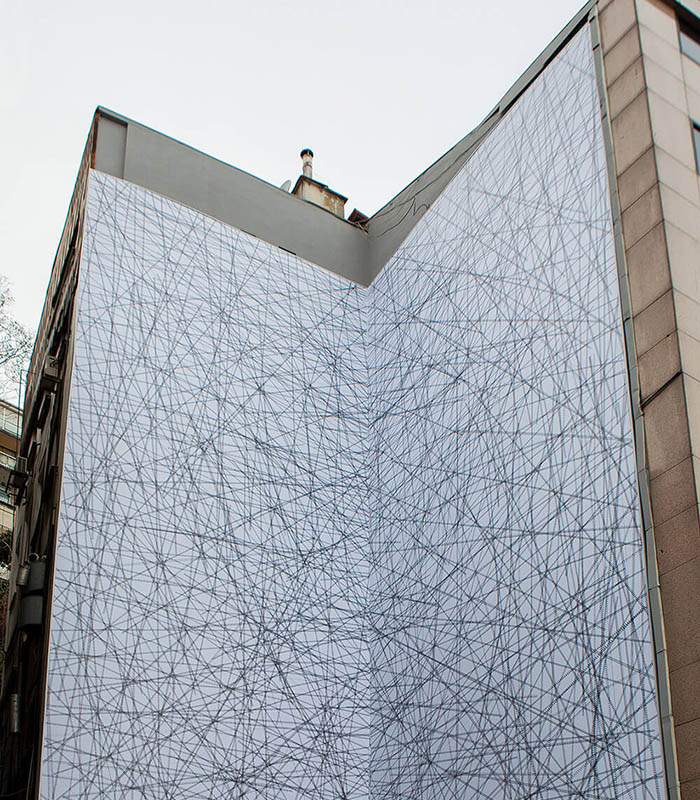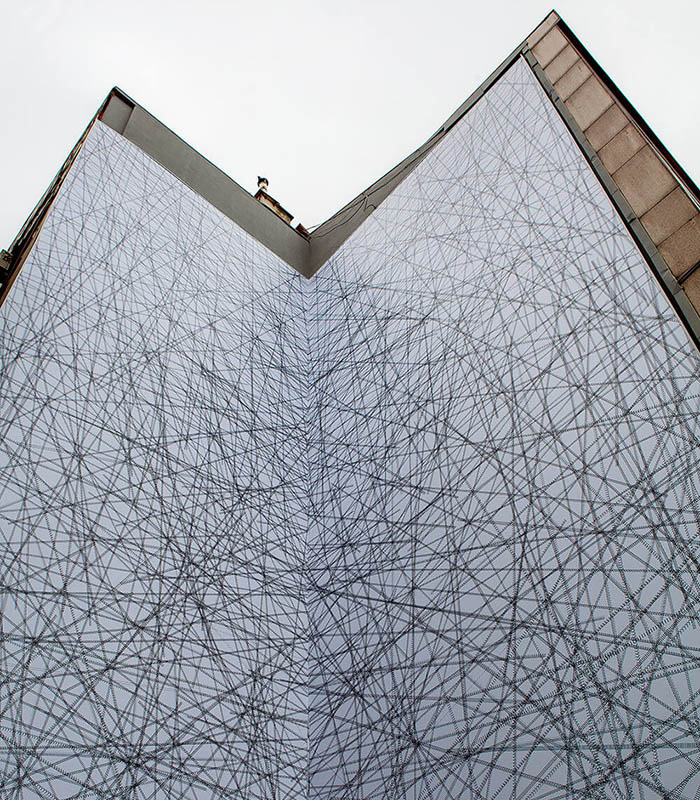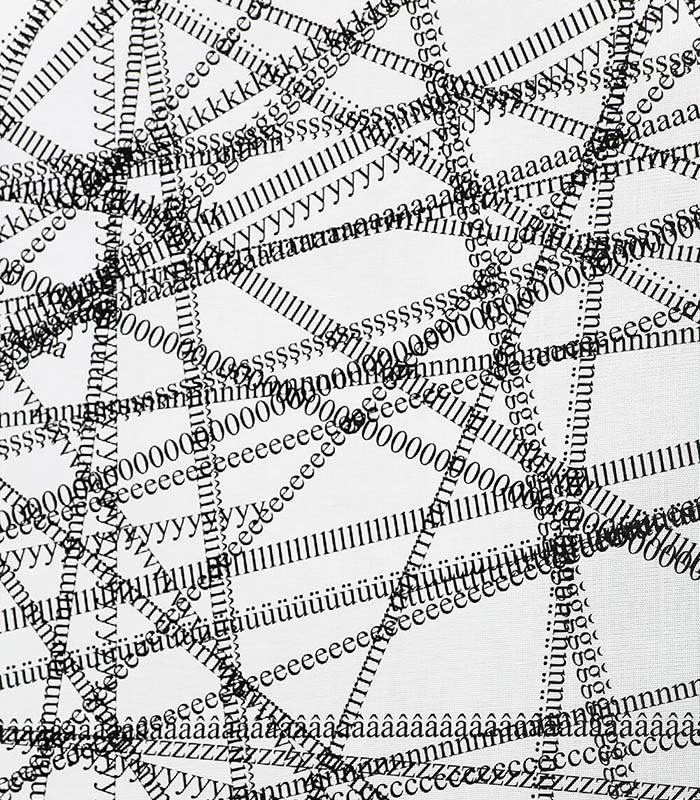Conversation: Nilüfer Şaşmazer
The project “SEPARATELYTOGETHER”, which you have realized for Yanköşe, presents the most recent version of the Constitution as an abstract, complex pattern. This is a work with a highly conceptual approach: what was your departure point during the preparation process?
“SEPARATELYTOGETHER” is the second public space project we have realized in Turkey. The first was a work we realized on Yüksel Street in Ankara, in 2011. Titled “Persuasion Exercises”, this work had been composed of poses given by political party leaders for photographs used on propaganda posters during the 2011 election period. The project had been installed on a billboard on Yüksel Street before the elections, and had been removed immediately after the elections. “Persuasion Exercises” is different compared to “SEPARATELYTOGETHER” since it emphasizes a humorous language that is much more direct and can be understood much faster, but the point that inspired us for both works is the same. When you acquire the right to say something in public space, this means carrying out an intervention in a space that belongs to all of us. Thus, the desire to say something on a matter that has a direct impact on all of us inevitably prevails. The project “SEPARATELYTOGETHER” was designed a few months after the 16 April 2017 referendum. The work contains the current text of the Constitution in its entirety.
The letters, numbers and punctuation marks in the text of the Constitution meet, in this work, only with signs similar to themselves, and they all turn into lines that extend out along different axes. In other words, in a sense, by fragmenting the entire content of the Constitution, you render it meaningless, but it also becomes pregnant with new meaning. So, does this work involve a call to the viewer, proclaiming, “Make your own sentence, create your own meaning”?
Yes, the work separates all the elements used in the text of the Constitution, and then brings every element together with those similar to itself, thus dissolving the text. However, the elements that are brought together with those similar to themselves remain the same in number. Therefore, the text of the Constitution continues to stand before our eyes with all its potential. Elements separated from the text lose their meaning, and as they lose their meaning, they become independent. From the moment that they gain their independence, they open a space for new sentences that may be formed by using them. “SEPARATELYTOGETHER” makes a visual proposal for the Constitution to become a form that holds us together with all our differences.
Constitutions are texts that ensure the basic rights and freedoms of individuals; from this viewpoint, a political perspective, or stance regarding the system in Turkey can also be sensed in the work. After all, your previous works, too, treat interrelated concepts and phenomena such as individual and collective belonging, political system and the construction of identity, language and symbols. Could we say that “SEPARATELYTOGETHER” is content-wise close to “Right” (2015) which superimposed the pages featuring the word “right” from the Constitution to render the whole illegible, and “Fresh Like the First Day” (2011) where you made separate books from all letters in the 1982 Constitution, and visually close to “Constitutive Lines” (2015) which you formed by superimposing the outlines of national flags?
“Fresh Like the First Day” is a work we created after the 2010 referendum. Like the work “SEPARATELYTOGETHER”, it separates all the elements that make up the Constitution from each other. However, in contrast to “SEPARATELYTOGETHER”, here, the elements do not desert their position in the text, instead, they retain their places and are divided into 53 books. In the A book there are only ‘a’s, in the 5 book there are only ‘5’s, and in the full stop book, there are only full stops. The work refers to our time at primary school when we first come across letters, numbers and punctuation marks, and renders the text open to potential constructs. Whereas the work “Right”, brings together all the “right”s in the text of the Constitution, pushes the rest of the text into the background, and underlines the fact that the primary task of the Constitution is to secure the basic rights and freedoms of individuals.
Both works were created during periods when there were debates over changes to the text of the Constitution. However, if we take a closer look, the work we created in 2011, “Fresh Like The First Day” is a more optimistic work. “Right”, a work we realized in 2015, reveals that concerns have increased. As for the elements that make up the text for “SEPARATELYTOGETHER” they are lined up after they have deserted their original places in the text, are chaotically regrouped to create a moment of incoherence. Although the work “Constitutive Lines” may seem visually close to “SEPARATELYTOGETHER”, the random grouping in “SEPARATELYTOGETHER” appears as order in “Constitutive Lines”.
The fact that this work is placed in a public space, and that it borrows its content from the Constitution also recalls the social contract. Would it be accurate to say that this work focuses on social consensus? And since it is installed in public space, is it different than your other works which focus on the relationship between the individual and the state?
Yes, it would be more accurate to say that this work focuses on social consensus. The Constitution is a text that concerns all of us. The new Constitution may have been approved with 51% of the vote, but we think that it should be our most natural right to demand a text that will ensure social consensus on a matter that will have an impact on 100% of us. The fact that the work will be exhibited in public space means that anyone who passes by will enter into a dialogue with the work, whether positive or negative. In this sense, the work is different from the works we have shown indoors, since it will communicate with many more people.
On the other hand, slicing up the Constitution also means to distort the social contract (once again, but in order, perhaps, to re-establish it in different ways). In this sense, could we suggest that your work also has an anarchistic dimension?
It is true that the work transmits the text of the Constitution onto a chaotic platform, however, one must not forget that “SEPARATELYTOGETHER” also potentially retains the currently effective text of the Constitution. We could say that our work searches for an answer to the question, “How can we create a new proposal from a thing that already exists?” In this sense, the work conveys the Constitution into the visual field, and transforms it by transferring it into another language. What we are trying to do here is to address the possibility of the text itself evolving into something more comprehensive, despite itself.
Although it has a deconstructionist aspect, the work, as its name also reveals, gestures towards the state of differences existing together; in fact, by indicating both an individual and collective stance, makes a call for the possibility of existing together, separately. When I think about this, I am also reminded of the previous work hosted at Yanköşe: Nermin Er’s work, too, emphasized living together. Her work focused more on the idea of people and animals living together on the scale of the city, while your work seems to treat the coexistence of people from a more abstract, intellectual and political perspective. In this sense, do you think it is possible to look at these works as different interpretations of the same concept?
“SEPARATELYTOGETHER” is not only a call to co-exist with all our differences, but it also emphasizes the impossibility of building a meaningful sentence without these differences. Our differences are revealed only when we are together, and that is when they assume meaning. In both Nermin’s work and ours, there is a focus on the right to life of those who are different to us, and a proposal to build a life together.
If we look at the relationship of the work with the space it is located in, we see that the two-dimensionality in its nature, through a certain kind of illusion, may be perceived as three-dimensionality. On the other hand, there is a cyclical impasse: From a distance, the work appears completely indecipherable, and complex; as you approach, you think that some meaning may be derived from familiar letters and signs; however, when you come even closer to the work, you understand that the letters and signs have not been arranged in a meaningful manner.
The incomprehensibility which you have referred to as a cyclical impasse in this context is based in the condition of something being both itself, and something else at the same moment. This is part of our work method. If you were to ask us, from a distance, the work is perceived as an abstract pattern, as you approach the work, you can make out that the lines are made up of letters, punctuation and other signs. As the viewers approach further, a signpost featuring the title of, and brief information about the work, help as a key. We could put it like this: The work presents itself in a few different ways to viewers that enter into a relationship with it from a distance, from close up, and from a very small distance.
Grand narratives like nation, flag and language do not only belong to Turkey, of course. You have previously applied the method of dismantling the constituent elements of these narratives also in works you have produced in Germany, where you have lived for a long time. In a work titled “Spread the Word” dated 2012, you removed certain words from the discourses of political parties, placed them in separate boxes, and invited the viewer to select the words she or he will use to build their own sentences from these boxes, and place them in a confetti gun. This work, along with others, remind me of the concept of the open work. Could we say that in your works, which you create in a fragmented structure, you invite the viewer, too, to interpret the work, and offer the viewer a certain amount of autonomy for the construction of meaning?
“Spread the Word” is a project that contains discursive elements used in the propaganda posters of political parties posted in public space during election periods in Germany. The work takes all the words used in these elements without discrimination and presents them in alphabetic order. In this way, every word gains its own independent position. However, since the work uses all the words that make up the discourse as they are, the index that emerges continues to remain linked to the discourse used in the poster. The condition we spoke of before exists here as well. The work tries to use the full potential of the thing it takes up (here, this is the discourses of political parties) to transform it into something else. In this sense, it is similar to “SEPARATELYTOGETHER”.
“Spread the Word” is an interactive project that is completed with the participation of the viewer. The work is made up of three parts: An index featuring words used in the discourses of political parties, thousands of small-scale prints of every single word in the index, and a confetti gun. The work could briefly be described as follows: The work invites the viewer to form her or his own discourse by using the words in the index. Every participant responding to the invitation forms her or his own discourse with the words she or he chooses from the index. Then she or he writes the discourse on two confetti guns, and fills both guns with the small-scale prints of the words he or she has used. While one of the guns that contains the new discourse is left beside the work, the other gun departs from the space with the viewer. In this way, words brought in from the public space are once again dispersed in the outside world, this time in the guise of different discourses.
As you also stated in your question, many of our works that have been constructed in a fragmentary manner, seek to open a space for the viewer to construct new meaning. And perhaps this should not be reduced solely to fragmentary works. Sometimes with the direct involvement of the audience as in “Spread the Word”, sometimes through a physical experience, as in “Hemzemin” a work we installed on a pavement in Dortmund, by melting a 12-metre-tall flag pole to transform it into a metal plate with a height of approximately 2 cm, and sometimes, as in “SEPARATELYTOGETHER” through a visual, aesthetic language, the works seek to open up a space for the viewer to form her or his own construction of meaning.
If you ask me, this work will open a significant space in the centre of Istanbul, not only with its visuality, but also with the debate it initiates, and the proposal it makes. Thank you very much, and congratulations!


